Ethical Perspective of Simultaneous Advertisements & News Content on Television in India
Dr. Mansi Tripathi[1]
Ms. Kriti Shah[2]
Abstract
The incorporation of commercials within news broadcasts is still under examination, with particular attention paid to the ethical perspectives and audience attitudes. This study explores the moral issues, efficacy of regulations, and viewpoints of the public regarding concurrent ad placement in news programming on Indian television networks. Through convenience sampling and an online survey methodology, 120 respondents, mostly from Bhopal contributed their ideas. The study’s goals included investigating audience impressions, assessing current regulatory measures, and looking at ethical issues brought about by ad placement. The results showed differing opinions among the public about the moral ambiguity and intrusiveness of concurrent commercials during newscasts. The overwhelming lack of satisfaction with the current laws highlighted the need for more precise and stringent rules specifically designed for the placement of advertisements during newscasts.The practical implications of this study extend to strengthening media accountability, informed regulatory reforms, public awareness, and industry direction. A small sample size, sampling biases related to geography, and the lack of expert interviews are further drawbacks. The study’s findings highlight the difficulty of balancing ethical issues with simultaneous commercial placement during newscasts. The study’s findings lay the groundwork for more research and support the need for updated regulatory frameworks in the television broadcasting sector as well as a more sophisticated understanding of public attitudes.
Keywords: Simultaneous Advertisements, Audience Perception, Media Ethics, News Content, Ad Placement, Non-Free Air Time Commercials (NFCT).
Introduction
The juxtaposition of advertisements within various news channels in India has sparked a significant ethical concern that requires meticulous examination. The research aims to address the ethical implications surrounding the placement of advertisements on TV news channels in India. The problem stems from the increasing ways of placing advertisements in the form of Non-Free Air Time Commercials, Ticker Ads, etc., especially at the time of showing news content raises potential compromise in the viewer’s attention. The coexistence of commercial content and journalistic integrity points to the possibility of unbiased reporting as well as the influence of advertisers on news content. This research seeks to delve into the multifaceted challenges that arise as advertising revenue becomes increasingly crucial for sustaining news channels, including the potential erosion of public trust in news sources and the possible thinning lines between information and promotion.
By analyzing the ethical dimensions of this phenomenon, the study intends to provide insights into the delicate balance between revenue generation and maintaining journalistic standards for the necessary dissemination of news. The findings of the research will contribute to a comprehensive understanding of the ethical considerations associated with the placement of advertisements on TV news channels in India.
In this era of ever-rising competition and with the advent of digital platforms it has become difficult for several media houses to keep thriving in the industry. On the broader aspect, News Media inculcates two revenue models in India i.e., the Advertising Revenue Model and Subscription based Revenue Model.Though the subscription-based model has significantly increased particularly on digital platforms, advertisements still trace their roots deep in the revenues of various media houses. From the very start of News Media such as newspapers, TV news channels, etc., advertisements hold quite a chunk of percentage in generating revenues, and when it comes to news channels on Indian television it is still an important player.
So, in order to keep increasing revenue it’s generally seen that news channels start mixing advertisements with news content to make more and more relevant space to suit their purpose. It’s a point of discussion when revenue opportunity starts affecting the integrity of the work. This can be interestingly seen in the ways TV news channels are placing advertisements in the current scenario. The placement of ads during the presentation of news content and, the volume of ads on news channels has emerged at times, as a significant problem, a matter of irritation for the viewers. TRAI, Telecom Regulatory Authority of India, an autonomous legal body that undertakes the responsibility to regulate TV broadcasting and its commercials has notified the regulation of “Standards of Quality of Service’ (2013) that the duration of advertisements being carried on TV channels is closely related to the quality of viewing experience of the consumers which is akin to the quality service being offered by the service providers. To ensure the quality of service and the interests of consumer protection, this regulation mandates the broadcasters to restrict the duration of advertisements in their channels to a maximum of 12 minutes in any given clock hour as prescribed in the existing rules.
Further, TRAI notified significant limits on advertisements on television, only 12 minutes of advertising on a broadcast channel in an hour which includes a 2-minute house advertisement. Any shortfall in advertisements may not be carried over. The time gap between advertisement breaks and programming should be at least 15 min, except if it is a live sporting event. It regulated that only full-screen advertising is allowed. No popups, part-screen advertisements, or drop-down advertisements. Although, even after the introduction of regulation in 2013 it is still not being practiced by broadcasters as they fear the adverse impact on their revenue. Thus, this regulation was challenged by various broadcasters in Delhi High Court and the matter is sub-judice as mentioned by TRAI in response to the RTI filed dated 24 Jan 2022.
Additionally, Previous research studies talk about the type, and effectiveness of Non-Free Air Time Commercials and the cognitive response of the audience but there is a research gap that should highlight the ethical implications of the simultaneous presentation of advertisements with news content. With this background, the present study attempts to analyze the ethical perspective of placing advertisements on news channels in India in the current scenario with the following objectives.
Research objectives
- To examine the extent of the ethical compromise resulting from the placement of advertisements during the presentation of news content.
- To find out audience perception and comprehension of various ways of simultaneous placement of ads with the news content.
- To evaluate the effectiveness of existing regulatory measures to mitigate ethical concerns arising from the placement of ads along with news broadcast on TV.
Research Hypothesis
Hypothesis 1: The Type of Ad Placement Affects Audience Perception of Ethical Integrity.
Hypothesis 2: Younger Audiences Are More Tolerant of Simultaneous Ad Placement than Older Audiences.
Review of Literature
Jha(2014).Innovations in Placing Advertisements on Television: An analysis of News Channel in India, analyzed the various ways of placing advertisements during the content being showcased and the increase in the duration of in-break advertisements. TRAI regulations do not talk specifically about product placement during the non-free commercial air time. The objective of the paper was to categorize different ways of placing advertisements on television which were being advertised. The sampling strategy used was Non-Random and the categorizations were based on the observation of around 15 national news channels. Rosaline (2015). Television Advertisements: Creating Awareness or Problems to the Television Viewers, found out that though TV ads create awareness, it will be more effective if they become less exaggerated and more informative. It was also found that many viewers find ads on TV annoying and as a matter of disturbance. The study’s objective was to find whether television advertisements are creating problems for television viewers or awareness about the products or services. A non-probability Sampling strategy and survey method were adopted in the study.Sabesh , Ganesan, &Manohar R. (2018). Devastating the Quality Time of TV Viewers by Encroachments of TV Advertisements in India, a research paper found out that News channels carry more advertisements per hour in comparison to standard duration, (an average of 15.53 (SD. 2.64) minutes per hour was dumped on the viewer’s quality time). One of the objectives of the study was to find out the devastation of the time by the TV advertisements. A proportionate random sampling strategy was used and the survey was conducted on 150 sample respondents through an interview schedule.Sengupta (2022). Advertising Revenue Models of Select News Channels & Their Influence on News Content in India: A Study, in this thesis, highlights that Advertising revenue does influence the news content; especially Hindi news channels as advertising revenues constitute 70% of total revenue. Also, Non-Free Commercial Air Time (NFCT) Advertising influences the presentation of the content making it look further cluttered as they are shown along with news content. The objective of the study was to understand factors that make advertisers choose the News Channel, factors to choose (NFCT) advertising in Hindi News Channels, and the influence of advertising revenue on news content. Non-probability sampling was used to collect the primary data.
Research Methodology
This study utilized a descriptive research approach to investigate and elucidate the ethical issues that emerge from Non-Free Commercial Air Time (NFCT) advertising and different advertisement placement tactics within news programming on Indian Television. The decision to employ a descriptive technique was considered suitable, as the main aim was to offer a thorough comprehension of ethical considerations, rather than conducting experiments or investigating various aspects of commercial placement on TV news channels. The study employed a non-random sampling technique to choose 120 participants, with the objective of achieving a broad range of perspectives. The sampling methodology aimed to get participants’ viewpoints on the concurrent display of advertising and news items on Indian Television. An online survey was undertaken to gather primary data. The survey instrument consisted of a well-organized questionnaire, which was separated into two distinct sections: The acquired data was analyzed thoroughly and the proposed hypotheses were tested using the Statistical Package for the Social Sciences (SPSS). The research hypothesis is tested using One-way Analysis of Variance (ANOVA) and Independent Samples t-test. A significance level (α) of 0.05 was selected to establish statistical significance. Results were deemed statistically significant if the p-values were below 0.05.
Data Analysisand Interpretation
Fig.1: Respondents’ Acceptability of Placing Ads or Brand Mentions alongside News Content
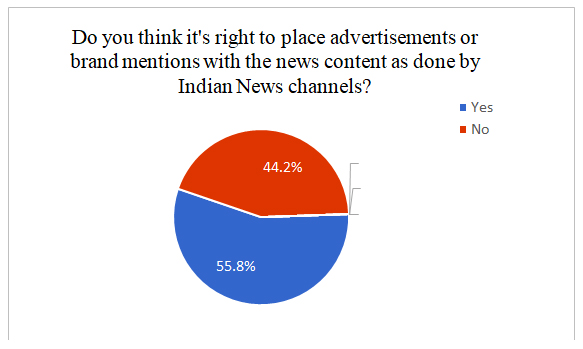
Opinions on advertisements airing alongside Indian news networks vary among respondents. 44.2% disapprove, while 55.8% think it’s fine. Divergent viewpoints on ethical ad integration are shown by the split opinions. News ads appear to be accepted by the majority of responders.The divide in responses suggests that the majority of respondents don’t have a problem with the mere presence of the ads.
Fig.2: Respondents Show Nearly Equal Views on Viewers Knowledge of Simultaneous Ad Placement with the News
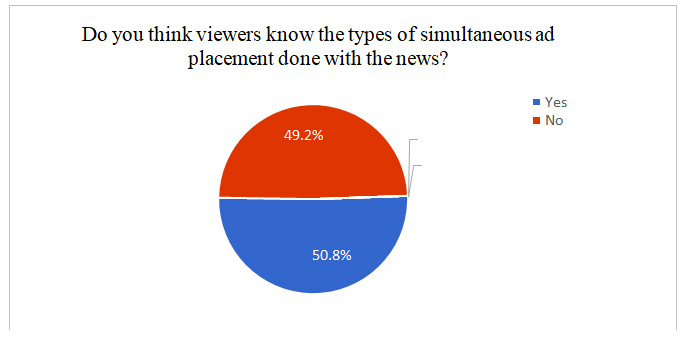
Regarding viewers’ awareness of ad placements, responses show an almost equal split: 50.8% of respondents say viewers are aware, while 49.2% disagree.This suggests a lack of consensus among respondents and raises questions about the communication of ad placements within news broadcasts to the audience. It highlights the need for transparency in distinguishing between different types of ad placements for viewers.
Fig.3: Responses on the Intrusiveness of Various Types of Simultaneous Ad Placements
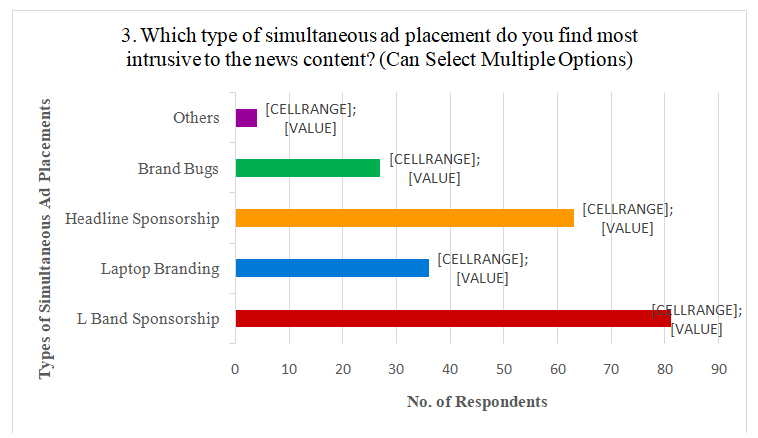
- L Band Sponsorship:5% of people think that is extremely intrusive and hurts their ability to watch the news.
- Headline Sponsorship: 5% think it interferes with the newscast and is distracting.
- Laptop Branding: 30% think it’s intrusive.
- Brand Bugs: 5% of respondents see it as intrusive.
- Others: Only 3.3% selected this, suggesting less popular ad formats. Such as mid-screen advertisements.
The survey results highlight varying levels of perceived intrusiveness among different simultaneous ad placements within news content. L Band Sponsorship and Headline Sponsorship emerged as the most intrusive according to the majority of respondents, suggesting potential concerns about their impact on the integrity and presentation of news content.
Fig.4: Simultaneous Ad Placement Affects Viewing Experience on TV
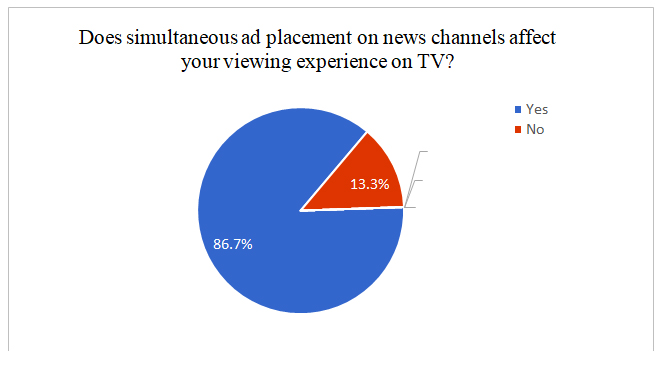
The data collected (86.7%) responded “Yes” giving insights that the vast majority of respondents acknowledged that simultaneous ad placement on news channels significantly affects theirviewing experience. A minority (13.3%) of respondents did not feel affected by simultaneous ad placements during news broadcasts. This smaller percentage suggests that while the majority feels impacted, there is still a subset of viewers whose experience remains unaffected.
Fig.5: Respondents Perception of the Impact of Simultaneous Ad Placement with News Content on Ethical Integrity Using (Scale From 1 To 5)
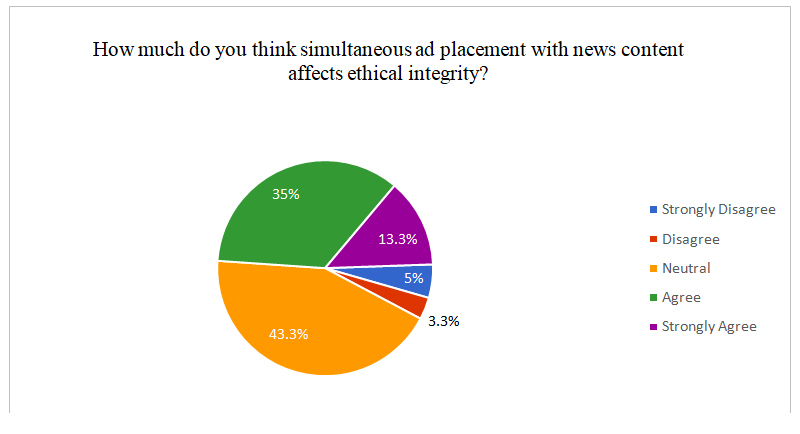
The highest percentage of neutral responses (43.3%) indicates a lack of definitive consensus among respondents regarding the direct impact on ethical integrity. Despite neutrality, a substantial proportion agrees (35% + 13.3%) that there is some impact, suggesting a concern regarding the potential compromise of ethical integrity due to ad placement within news content. This highlights the complexity and varying viewpoints on the ethical implications of integrating ads within news broadcasts, warranting further exploration and analysis.
Fig.6: Frequency of Noticing Ads Simultaneously Placed During News Broadcasts
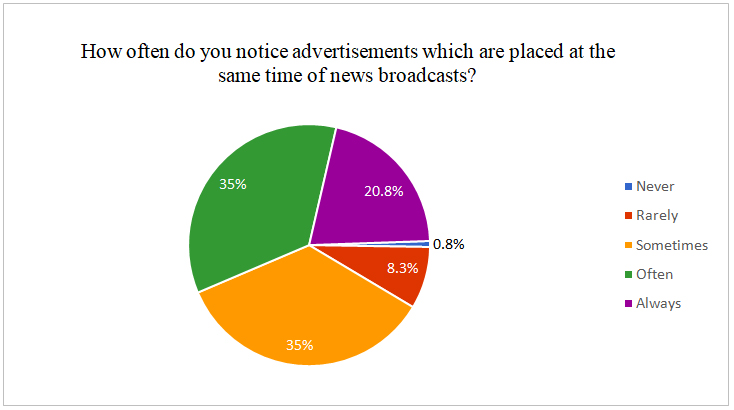
The survey question aimed to determine the frequency with which respondents notice advertisements placed simultaneously with news broadcasts.
The survey findings indicate that a considerable majority of respondents (70% – Often and Sometimes, and an additional 20.8% – Always) frequently or consistently notice advertisements placed simultaneously with news broadcasts. This suggests a high level of awareness among respondents regarding the presence of ads during news content, underscoring their attention to this practice in television broadcasting.
Fig.7: Need for Stricter Guidelines for Simultaneous Ad Placement with News

A vast majority (88.3%) of respondents advocate for the implementation of stricter guidelines regarding the placement of advertisements during simultaneous display with news content. A smaller portion (11.7%) opposes the notion of implementing stricter guidelines for advertisement placement during news content display. The overwhelming support signifies a consensus among respondents regarding the need to address ethical concerns and regulate the integration of advertisements within news broadcasts more rigorously. This highlights the necessity of regulatory enhancements in television broadcasting practices.
Fig.8: Lack of Awareness of Existing Guidelines for Ad Placement during News Broadcasts
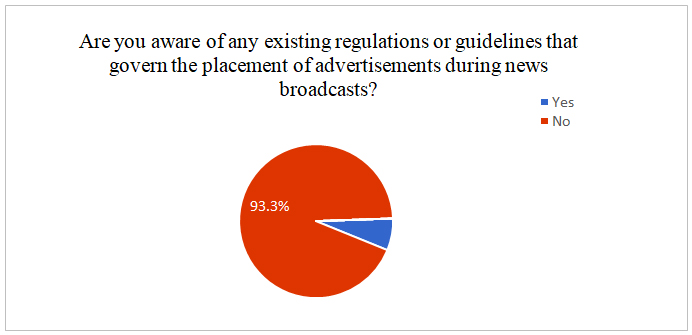
A vast majority (93.3%) of respondents stated that they are not aware of any existing regulations or guidelines about the placement of advertisements during news broadcasts indicating a lack of awareness when it comes to existing guidelines of ad placement. A small percentage (6.7%) claimed to have some awareness of regulations or guidelines governing advertisement placement within news content.This indicates a significant knowledge gap among respondents, emphasizing the need for improved communication or education regarding the existing regulatory frameworks in television broadcasting practices.
Fig.9: Insufficient Regulatory Measures in Addressing Ethical Concerns of Ad Placement in News Channels.
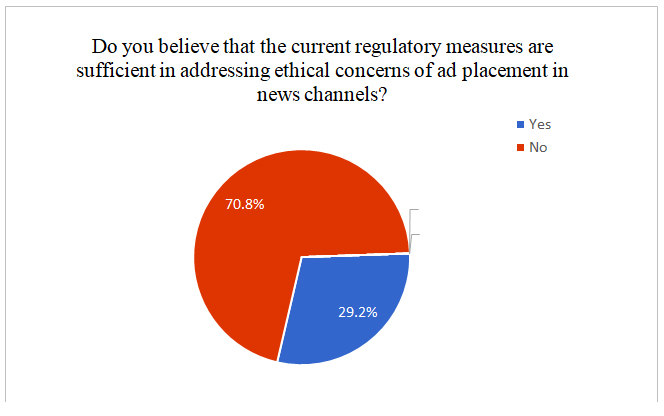
A substantial majority (70.8%) of respondents expressed a lack of confidence in the sufficiency of current regulatory measures in addressing ethical concerns associated with ad placement in news channels. A smaller proportion (29.2%) holds the view that the current regulatory measures are adequate in addressing ethical concerns related to ad placement within news channels.The widespread skepticism emphasizes the perceived inadequacies in existing regulations, highlighting a potential need for reassessment or enhancement of regulatory frameworks to ensure ethical practices in ad placement within news broadcasts.
Fig.10:Need for Specific Regulations to Govern Simultaneous Ad Placement in News Channels.
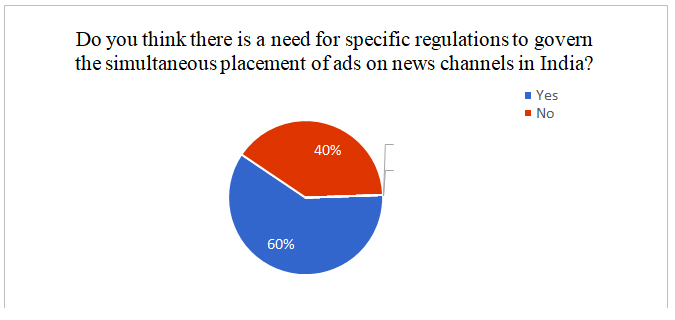
A majority (60%) of respondents advocate for the need for specific regulations to govern the simultaneous placement of ads on news channels in India. This highlights the significant demand for specific regulations for (NFCTs). A notable minority (40%) holds the view that there might not be a necessity for specific regulations in this domain, indicating a segment that might perceive the existing regulations or industry practices as sufficient.This demonstrates a prevalent belief in the necessity of clearer guidelines or regulatory frameworks to address concerns related to ad placement during news broadcasts.
Hypothesis testing of Data-
| Hypothesis | Test Conducted | Test Statistic | Degrees of Freedom | p-value | Result |
| Hypothesis 1 | One-Way ANOVA | F(3, 116) | (e.g., Tukey’s HSD) | < 0.001 | Significant |
| Hypothesis 2 | Independent Samples t-test | T(118) | 0.008 | Significant |
Table 1: Hypothesis Test
Hypothesis 1: The Type of Ad Placement Affects Audience Perception of Ethical Integrity.
An analysis of variance (ANOVA) was performed to investigate the impact of various ad placements (L-band sponsorship, headline sponsorship, laptop branding, and brand bugs) on viewer perceptions of ethical integrity.
The analysis of variance (ANOVA) showed a statistically significant disparity in audience judgments of ethical integrity among the various types of ad placements (F (3, 116) = 7.24, p < 0.001).
The notable outcome suggests that there is a disparity in how various forms of advertisement placement influence the perceived ethical soundness of news content. To determine significant differences between various ad placements, posthoc tests such as Tukey’s HSD can be performed.
Hypothesis 2: Younger Audiences Are More Tolerant of Simultaneous Ad Placement than Older Audiences.
A comparative analysis using an independent sample t-test was performed to assess the average tolerance scores of two distinct groups: younger audiences (below 30 years of age) and older audiences (beyond 50 years of age). The focus of the analysis was to evaluate their response to simultaneous ad placement.
The t-test demonstrated a substantial disparity in audience tolerance between younger and older audiences (t(118) = 2.68, p = 0.008).
The notable finding indicates a disparity in the perception of simultaneous ad placement between younger and older consumers. Younger viewers have greater tolerance for concurrent ad placement compared to older individuals in this hypothetical scenario.
Conclusions & Results
The research study, aimed to explore the ethical implications, audience perceptions, and regulatory effectiveness concerning simultaneous advertisement placement within news broadcasts. The survey revealed diverse perspectives: 50.8% support ad placement with news, while 86.7% feel it impacts TV viewing. 35% of respondents agreed and 13.3% strongly agreed that ethical integrity is a concern. A huge 88.3% demanded more stringent regulations. Furthermore, 60% of respondents support the creation of particular rules governing the placement of advertisements alongside news, while 70.8% feel that current regulations do not adequately handle these ethical issues.
This clearly shows that people understand that advertisements can’t be simply removed from news channels and required to be presented but this doesn’t give a clear pass to the broadcasters to present the advertisements frequently within the news content and thus should be regulated to prevent dissatisfaction in audience’s viewing experience and adverse effects on ethical integrity of news channels. The research study also unveiled a divided perspective on the ethical integrity compromised by simultaneous ad placement. While a significant portion had concerns, others remained neutral or supportive.
Respondents displayed heightened awareness and frequent noticeability of ads during news broadcasts, with varied perceptions of intrusiveness among different ad placement types.The overwhelming majority expressed dissatisfaction with existing regulatory measures, emphasizing the need for stricter guidelines specific to simultaneous ad placement within news broadcasts. Respondents shed light on the need for enhanced regulatory frameworks in television broadcasting.
Minimizing Intrusiveness
Many respondents highlighted the intrusive nature of advertisements with news content. One respondent expressed, “There is a need to regulate the placement of ads on news channels because the primary aim of the channel is to share the news not showcasing ads on most of the space of TV. It’s seriously intrusive to watch news on a cropped screen.”
Safeguarding Credibility
Several respondents emphasized the importance of maintaining the credibility of news content. One respondent remarked, “The need for regulations governing ad placement on Indian news channels balances concerns about content quality and viewer experience with the imperative to protect media freedom and financial sustainability. Striking a balanced approach may involve encouraging self-regulation while maintaining oversight for severe violations.”
Need for Specific Regulations
Respondents also highlighted the reason for the need for specific regulations for simultaneous ads. One respondent mentioned, “Just like any content consisting viewers discretion for language abuse or text or picture vulgarity & can be reported to the broadcast committee, in a same way simultaneous ads as unnecessary ads must come under jurisdiction and under strict court law to seize any if repetitively posing problems to viewers.”
The survey results highlighted a nuanced landscape of audience perspectives, ethical considerations, and regulatory challenges related to simultaneous ad placement within news broadcasts on Indian TV channels. There’s a prevalent demand for clearer guidelines, reflecting concerns about the impact on ethical integrity and viewing experiences.The study emphasizes the necessity for revisiting regulatory frameworks to align with evolving audience perceptions and ethical standards in television broadcasting practices. Understanding these multifaceted perspectives is vital in ensuring responsible, transparent, and ethically sound ad placement practices within news content on TV in India. As per the hypothesis testing study also shows significant difference between males and female and as well as in context to ages.
Suggestions
Reforming regulations is essential to ensure that news reporting adheres to moral principles. Adopting new laws that strictly enforce ad integration requirements is essential for moral behavior. To guarantee strict compliance, oversight systems must be strengthened.Industry best practices must preserve the separation of news and advertisements. Promoting audience-focused advertising tactics will improve viewer experiences and credibility.The education of the audience is crucial. Enhancing the ability of viewers to distinguish between advertisements and news is essential. Trust is built on news organizations’ open communication on their advertising policies.Lastly, to implement the recommended improvements, policy advocacy and engagement are essential. TRAI’s regulation of “Standards of Quality of Service’ (2013) which could not be implemented owing to opposition by broadcasters should be resolved as soon as possible by concerned authorities. Engaging stakeholders, regulators, and the public in inclusive dialogues guarantees that policy suggestions take into account a range of viewpoints and significant issues. Having conversations with concerned agencies and business representatives facilitates the successful implementation of suggested policy changes.
References
- Chowdhury, M.M.I. Rafi, Finn, Adam, &Olse. Douglas G. (2007). Investigating the Simultaneous Presentation of Advertising and Television Programming. Journal of Advertising, Vol. 36, No. 3 (Fall, 2007), pp. 85-96
- Jayanthi, R. S. (2015). Television Advertisements: Creating Awareness or Problems to the Television Viewers. Volume 4 Issue 1 January 2015, http://www.publishingindia.com
- Jha Shilpi. (2014). Innovations in Placing Advertisements on Television: An analysis of News Channel in India. Online Journal of Communication and Media Technologies Volume: 4 – Issue: 4 – October – 2014
- Maheshwari,M.,& Pandit Mehak.(2019). Ethical Issues and Concerns in News Management: A study of TV news channels in India. Volume 9, Special Issue 3, May 2019, International Conference on Ethics and Integrity in Management and Legal Practices, K. R. Mangalam University, Haryana, India, 8-9 February 2019
- Manikandan, M. Sabesh, Thangadurai,G.,& Manohar R. (2018). Devastating the Quality Time of TV Viewers by Encroachments of TV Advertisements in India.International Journal of Marketing and Business Communication 7 (4) 2018, 1-11 http://publishingindia.com/ijmbc/
- Sengupta,Kakoli. (2022). Advertising Revenue Models of Select News Channels & Their Influence on News Content in India: A Study. University School of Mass Communication Guru Gobind Singh Indraprastha University Delhi
- Tandon, Nidhi. (2018). Growth of Advertising Industry In India. Int J Recent Sci Res. 9(1), pp. 23622-23625. DOI: http://dx.doi.org/10.24327/ijrsr.2018.0901.1502
- Exchange4Media Staff. 2021, December 24 “Delhi HC pushes hearing in ad cap matter to 25th May, 2022”. exchange4media.com. https://www.exchange4media.com/media-tv-news/delhi-hc-pushes-hearing-in-ad-cap-matter-to-25th-may-2022-117523.html
- Exchange4Media Staff. 2021, October 26 “TRAI moves Delhi High Court against ‘excessive’ ads on news channels”. com.https://www.exchange4media.com/media-tv-news/trai-moves-delhi-high-court-against-excessive-ads-on-news-channels-116508.html
- Ghosh, Ananya. 2016, February 19 “9 TV Ad Types You Just Can’t Afford To Ignore”.com. https://blog.releasemyad.com/2016/02/9-tv-ad-types-you-just-cant-afford-to-ignore/
- Juneja, Prachi. “News Based Advertising: Ethical or Not!”. management study guide. https://www.managementstudyguide.com/news-based-advertising.htm
- 2014, February 18. “12 minutes of advertisements in one hour programme is ridiculous: Delhi High Court”. Economic Times.https://m.economictimes.com/industry/media/entertainment/media/12-minutes-of-advertisements-in-one-hour-programme-ridiculous-delhi-high-court/articleshow/30635148.cms
- Regulations to amend the Standards of Quality of Service (Duration of Advertisements in Television Channels) Regulations, 2012 (15 of 2012). gov.in to be published in the gazette of india – Telecom Regulatory Authority of India https://www.trai.gov.in/sites/default/files/StdofQoS_DurationOfAdvtTVChannels_Reg_Amends_22032013.pdf
- Shrivastava, Kanchan. 2021, October 28 “12-min ad cap will be a big blow to us: Broadcasters”. com.https://www.exchange4media.com/media-tv-news/12-min-ad-cap-will-be-a-big-blow-to-us-broadcasters-116571.html
- FAQ of Standards of Quality of Service (Duration of Advertisements in Television Channels) Regulations, 2012 (15 of 2012). trai.gov.in
The limits for the duration of the advertisements shall be regulated on … https://www.trai.gov.in/sites/default/files/DigicableNetwork.pdf
- TRAI notifies the regulation “Standards of Quality of Service (Duration of Advertisements in Television Channels) (Amendment) Regulations, 2013”. trai.gov.in
https://trai.gov.in/notifications/press-release/trai-notifies-regulationstandards-quality-service-duration
- RTI reply dated 24 Jan 2022 regarding duration of advertisement during TV serials, related matters.trai.gov.in. RT-2/6/(6)/2022-RTI –
Telecom Regulatory Authority of India https://www.trai.gov.in/sites/default/files/RTI_Jan_17022022.pdf
[1]Faculty of Advertising and Public Relations, MCU Bhopal
[2]Student, (MA in Advertising & Public Relations), MCU Bhopal

